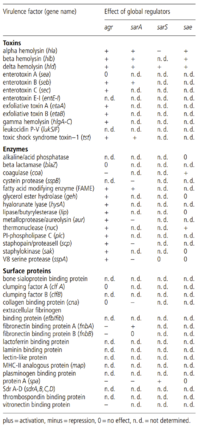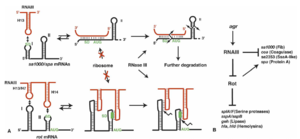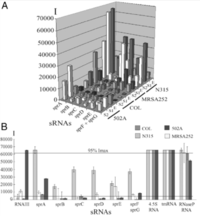Regulatory RNA Controls for Virulence in Staphylococcus aureus: Difference between revisions
No edit summary |
|||
| Line 42: | Line 42: | ||
==Conclusion== | ==Conclusion== | ||
Given the importance of <i>Staphylococcus aureus</i> as a large and ever growing concern within medical settings around the world, finding ways to combat this bacteria’s viral tendencies will greatly improve the safety and effectiveness of our healthcare systems. Understanding the mechanisms that control for virulence in <i>S. aureus</i> will greatly aid in this endeavor, providing us with possible treatment targets to limit the spread and intensity of infections. RNA I, RNA III, SprA, SprC, and SprD have all shown involvement in regulatory processes of virulence is <i>S. aureus</i>. It is important to keep in mind, however, that our knowledge regarding this topic is constantly evolving with new research. While a relatively small number of regulatory RNA molecules have been identified as participants in virulence regulation, there are likely many more RNAs that hold related roles in <i>S. aureus</i>. | Given the importance of <i>Staphylococcus aureus</i> as a large and ever growing concern within medical settings around the world, finding ways to combat this bacteria’s viral tendencies will greatly improve the safety and effectiveness of our healthcare systems. Understanding the mechanisms that control for virulence in <i>S. aureus</i> will greatly aid in this endeavor, providing us with possible treatment targets to limit the spread and intensity of infections. RNA I, RNA III, SprA, SprC, and SprD have all shown involvement in regulatory processes of virulence is <i>S. aureus</i>. It is important to keep in mind, however, that our knowledge regarding this topic is constantly evolving with new research. While a relatively small number of regulatory RNA molecules have been identified as participants in virulence regulation, there are likely many more RNAs that hold related roles in <i>S. aureus</i>. | ||
<br><br><br><br><br><br><br><br><br> | |||
==References== | ==References== | ||
<references /> | <references /> | ||
<br><br>Authored for BIOL 238 Microbiology, taught by [mailto:slonczewski@kenyon.edu Joan Slonczewski], 2021, [http://www.kenyon.edu/index.xml Kenyon College]. | <br><br>Authored for BIOL 238 Microbiology, taught by [mailto:slonczewski@kenyon.edu Joan Slonczewski], 2021, [http://www.kenyon.edu/index.xml Kenyon College]. | ||
Revision as of 01:48, 8 April 2021
By Zachary Baker
Introduction

Staphylococcus aureus is a gram-positive bacteria that is naturally found in the nasal cavity of many individuals as a commensal member of the nose microbiome. On certain occasions, most notably in clinical settings in which patients may have weakened immune systems or have recently experienced medical procedures, S. aureus may abnormally enter other parts of the body and cause dangerous infections [2]. S. aureus is the most common cause of Staphylococcal infections and the primary treatment to combat infection with S. aureus is the use of antibiotics such as methicillin [3]. A growing concern regarding the treatment of infection by S. aureus and other bacteria is the increasing presence of antibiotic resistant strains of bacteria in medical settings, an issue that can be partially and temporarily addressed through the development of novel antibiotics [4]. In order to develop effective antibiotics and better control bacterial infections, we must understand the mechanisms that control and contribute to the virulence of bacteria such as S. aureus. One such method of virulence control is the use of regulatory RNA molecules to control the expression and activity of virulence factors in bacteria.
Virulence in Staphylococcus aureus
Staphylococcus aureus infections are characterized by a number of virulence factor proteins that contribute to its pathogenic success. Adherence factors, or adhesins, facilitate the attachment of S. aureus to the host extracellular matrix. Adherence factors related to S. aureus infections are known as microbial surface components recognizing adhesive matrix molecules and are thus a part of the MSCRAMM family of protein adhesins [5]. A much broader group of proteins known as exoproteins are also produced by S. aureus to be secreted during infection; such proteins include exotoxins and enzymes that tend to assist in the infection cycle while harming the host organism. Cytolytic proteins released by S. aureus lead to pore formation in host cells, causing cell leakage and eventually cell lysis [6]. Another notable group of exotoxins produced by S. aureus is the superantigens: antigenic molecules that bypass the typical immune system antigen recognition process, leading to an influx in T cell proliferation and cytokine release that leads to an immune system overresponse and thus toxic shock [7]. S. aureus also produces a number of exoproteins, such as the FLIPr and CHIPS proteins, that inhibit the immune system’s ability to respond to the S. aureus infection [8].
Expression of these virulence factors is mediated by a complicated network of global regulatory elements that allow S. aureus to precisely control its protein production throughout the infection timeline. The two primary protein groups responsible for virulence factor regulation in S. aureus are the two-component regulatory systems and the SarA protein family [9]. An example of a two-component regulatory system, along with a demonstration of the complexity of the topic and our lack of familiarity with it, is the saeRS regulatory system. The transcription pattern of sae is quite complicated and changes within the growth cycle of a cell. Additionally, sae is expressed from several promoters, giving rise to four or five unique transcripts- some of which have two reading frames. It is also suggested that sae interacts with the agr quorum sensing system within the exoprotein activation pathways as a means of coordinating this process with environmental signals, although little is known about the details of this possible association [10]. Members of the SarA protein family also play an important role. For example, S. aureus proteins SarA and one of its homologues, SarS, act mainly as a downregulator and activator of genes important to the infection cycle [11].
Role of the Accessory Gene Regulator Locus in Virulence

The accessory gene regulator (agr) locus is vital to the infection cycle of Staphylococcus aureus, acting as a regulator for the production of virulence factors and other molecules related to virulence [13]. Agr is known to consist of two transcriptional units. The first unit is transcribed from the promoter P2 and codes for a two component regulatory system and an autoinducing peptide molecule. The second unit is transcribed from the promoter P2 and encodes RNA III, a regulatory RNA molecule that also encodes the delta-toxin secreted by S. aureus [1]. The agr locus also allows S. aureus to regulate its virulence factors through a quorum sensing system [12]. In total, the agr locus has been shown to upregulate transcription of 104 genes and downregulate 34 genes in a cell density and agr-dependent manner. 20 of the 104 upregulated genes and two of the downregulated genes are related to virulence in S. aureus, with one additional downregulated gene that is a potential virulence factor [14]. The agr regulatory network includes a vast number of components, not all of which are listed here, and not every detail is known about the mechanisms by which it works.
RNA III Transcription Regulator
Of the documented regulatory RNA molecules used by Staphylococcus aureus to control the production of virulence factors, RNA III is the most thoroughly studied. RNA III is found within the agr locus of the S. aureus genome where it encodes mRNA used to create delta-hemolysin, one of the toxins released during the S. aureus infection cycle[15]. In addition to its protein-encoding role, RNA III acts as a stimulatory molecule for the transcription of genes that encode secreted toxins and enzymes. The 5’ end of the RNA III molecule shows significant complementarity with an untranslated region of hla, the mRNA molecule that codes for alpha-toxin in S. aureus. This allows RNA III to bind the hla molecule, preventing the formation of a stem-loop structure and exposing the ribosome binding site [16].

RNA III has also shown involvement in virulence factor production as a translation repressor of mRNA molecules such as the spa mRNA and those coding for products such as an adhesin and a secretory antigen precursor. RNA III performs this duty by binding the target mRNA sequences using its antisense 3’ domain to directly block translation; this process also induces rapid degradation of these target mRNA molecules. Although not yet confirmed, it has been predicted that RNA III similarly targets a number of other mRNA molecules coding for other proteins related to virulence. The initial mRNA-RNA III interaction is thought to be facilitated by a 5’ hairpin loop structure present within the target mRNA sequences that contains the molecule’s Shine–Dalgarno sequence. The bonding of RNA III to mRNA yields an extended RNA duplex, likely marking the molecule as a target for RNase III. Along with directly influencing the production of virulence factors in S. aureus, RNA III has been shown to bind the mRNA transcript for the Rot protein [17], an important member of the S. aureus virulence regulatory network and a member of the Sar family of regulatory proteins [18].
The antisense molecule RNA I has also been shown to exhibit regulatory effects relating to virulence in staphylococcal bacteria such as as S. aureus, although this molecule seems to regulate the replication of a multi-resistance plasmid as opposed to directly controlling the production of virulence factors [19].
Spr Transcription Regulators

SprA through SprG are sRNA molecules produced by Staphylococcus aureus, all of which are encoded on pathogenicity islands within the S. aureus genome. The variation present within a number of these products along with their presence on pathogenicity islands suggests that these molecules may be involved in virulence regulation, although this is only confirmed for a few of them such as SprA which is suspected to have a role in regulating expression of an ABC transporter [20]. The SprC sRNA was found to inhibit virulence and host uptake within a mouse model organism, suggesting that it plays a role in limiting the destructive capabilities of S. aureus. SprC demonstrates a modest yet noticeable negative regulatory effect on the major staphylococcal autolysin (ATL) that facilitates host uptake of S. aureus. This regulatory effect occurs due to SprC’s binding to the atl mRNA, an event that inhibits ribosome binding to atl [21]. SprD contributes to the virulence of S. aureus as a negative regulator of the immune-evasion IgG binding protein (Sbi). SprD seems to fulfill this duty by binding to and inhibiting expression of the sbi mRNA sequence, enhancing the virulence of S. aureus [22].
Conclusion
Given the importance of Staphylococcus aureus as a large and ever growing concern within medical settings around the world, finding ways to combat this bacteria’s viral tendencies will greatly improve the safety and effectiveness of our healthcare systems. Understanding the mechanisms that control for virulence in S. aureus will greatly aid in this endeavor, providing us with possible treatment targets to limit the spread and intensity of infections. RNA I, RNA III, SprA, SprC, and SprD have all shown involvement in regulatory processes of virulence is S. aureus. It is important to keep in mind, however, that our knowledge regarding this topic is constantly evolving with new research. While a relatively small number of regulatory RNA molecules have been identified as participants in virulence regulation, there are likely many more RNAs that hold related roles in S. aureus.
References
- ↑ 1.0 1.1 Arvidson, S., & Tegmark, K. (2001). Regulation of virulence determinants in Staphylococcus aureus. International Journal of Medical Microbiology, 291(2), 159-170. https://doi.org/10.1078/1438-4221-00112
- ↑ Staphylococcus aureus in Healthcare Settings. (2011, January 17). Centers for Disease Control and Prevention. Retrieved March 16, 2021, from https://www.cdc.gov/hai/organisms/staph.html
- ↑ Staphylococcal Infections. (2016, August 25). MedlinePlus. Retrieved March 16, 2021, from https://medlineplus.gov/staphylococcalinfections.html
- ↑ Cohen, M. (1992). Epidemiology of Drug Resistance: Implications for a Post-Antimicrobial Era. Science, 257(5073), 1050-1055. Retrieved March 16, 2021, from http://www.jstor.org/stable/2879831l
- ↑ Foster, T. J., & Höök, M. (1998). Surface protein adhesins of Staphylococcus aureus. Trends in microbiology, 6(12), 484-488. https://doi.org/10.1016/S0966-842X(98)01400-0
- ↑ Foster, T. J. (2005). Immune evasion by staphylococci. Nature reviews microbiology, 3(12), 948-958. https://doi.org/10.1038/nrmicro1289
- ↑ Holtfreter, S., & Bröker, B. M. (2005). Staphylococcal superantigens: do they play a role in sepsis?. Arch Immunol Ther Exp, 53, 13-27.
- ↑ Bien, J., Sokolova, O., & Bozko, P. (2011). Characterization of virulence factors of Staphylococcus aureus: novel function of known virulence factors that are implicated in activation of airway epithelial proinflammatory response. Journal of pathogens, 2011. https://doi.org/10.4061/2011/601905
- ↑ Cheung, A. L., Bayer, A. S., Zhang, G., Gresham, H., & Xiong, Y. Q. (2004). Regulation of virulence determinants in vitro and in vivo in Staphylococcus aureus. FEMS Immunology & Medical Microbiology, 40(1), 1-9. https://doi.org/10.1016/S0928-8244(03)00309-2
- ↑ Novick, R. P., & Jiang, D. (2003). The staphylococcal saeRS system coordinates environmental signals with agr quorum sensing. Microbiology, 149(10), 2709-2717. https://doi.org/10.1099/mic.0.26575-0
- ↑ Cheung, A. L., Schmidt, K., Bateman, B., & Manna, A. C. (2001). SarS, a SarA homolog repressible by agr, is an activator of protein A synthesis in Staphylococcus aureus. Infection and Immunity, 69(4), 2448-2455. https://doi.org/10.1128/IAI.69.4.2448-2455.2001
- ↑ 12.0 12.1 Kleerebezem, M., Quadri, L. E., Kuipers, O. P., & De Vos, W. M. (1997). Quorum sensing by peptide pheromones and two‐component signal‐transduction systems in Gram‐positive bacteria. Molecular microbiology, 24(5), 895-904. https://doi.org/10.1046/j.1365-2958.1997.4251782.x
- ↑ Recsei, P., Kreiswirth, B., O'reilly, M., Schlievert, P. M., Gruss, A., & Novick, R. P. (1986). Regulation of exoprotein gene expression in Staphylococcus aureus by agr. Molecular and General Genetics MGG, 202(1), 58-61. http://rave.ohiolink.edu/ejournals/article/315402615
- ↑ Dunman, P. Á., Murphy, E., Haney, S., Palacios, D., Tucker-Kellogg, G., Wu, S., ... & Projan, S. J. (2001). Transcription profiling-based identification of Staphylococcus aureus genes regulated by the agrand/or sarA Loci. Journal of bacteriology, 183(24), 7341-7353. DOI: 10.1128/JB.183.24.7341-7353.2001
- ↑ Papenfort, K., & Vogel, J. (2010). Regulatory RNA in bacterial pathogens. Cell host & microbe, 8(1), 116-127. https://doi.org/10.1016/j.chom.2010.06.008
- ↑ Morfeldt, E., Taylor, D. V., Von Gabain, A., & Arvidson, S. (1995). Activation of alpha‐toxin translation in Staphylococcus aureus by the trans‐encoded antisense RNA, RNAIII. The EMBO journal, 14(18), 4569-4577. https://doi.org/10.1002/j.1460-2075.1995.tb00136.x
- ↑ 17.0 17.1 Boisset, S., Geissmann, T., Huntzinger, E., Fechter, P., Bendridi, N., Possedko, M., ... & Romby, P. (2007). Staphylococcus aureus RNAIII coordinately represses the synthesis of virulence factors and the transcription regulator Rot by an antisense mechanism. Genes & development, 21(11), 1353-1366. doi: 10.1101/gad.423507
- ↑ Oscarsson, J., Harlos, C., & Arvidson, S. (2005). Regulatory role of proteins binding to the spa (protein A) and sarS (staphylococcal accessory regulator) promoter regions in Staphylococcus aureus NTCC 8325-4. International journal of medical microbiology, 295(4), 253-266. https://doi.org/10.1016/j.ijmm.2005.05.003
- ↑ Kwong, S. M., Skurray, R. A., & Firth, N. (2004). Staphylococcus aureus multiresistance plasmid pSK41: analysis of the replication region, initiator protein binding and antisense RNA regulation. Molecular microbiology, 51(2), 497-509. https://doi.org/10.1046/j.1365-2958.2003.03843.x
- ↑ 20.0 20.1 Pichon, C., & Felden, B. (2005). Small RNA genes expressed from Staphylococcus aureus genomic and pathogenicity islands with specific expression among pathogenic strains. Proceedings of the National Academy of Sciences, 102(40), 14249-14254. https://doi.org/10.1073/pnas.0503838102
- ↑ Le Pabic, H., Germain-Amiot, N., Bordeau, V., & Felden, B. (2015). A bacterial regulatory RNA attenuates virulence, spread and human host cell phagocytosis. Nucleic acids research, 43(19), 9232-9248. https://doi.org/10.1093/nar/gkv783
- ↑ Chabelskaya, S., Gaillot, O., & Felden, B. (2010). A Staphylococcus aureus small RNA is required for bacterial virulence and regulates the expression of an immune-evasion molecule. PLoS Pathog, 6(6), e1000927. https://doi.org/10.1371/journal.ppat.1000927
Authored for BIOL 238 Microbiology, taught by Joan Slonczewski, 2021, Kenyon College.
